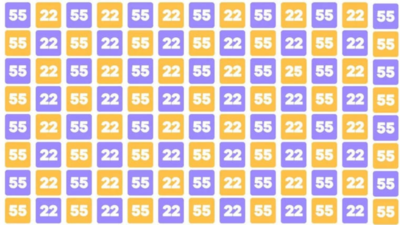- News
- lifestyle
- health-fitness
- de-stress
- Optical Illusion: You need to be exceptionally skilled to spot the single 25
Trending
Optical Illusion: You need to be exceptionally skilled to spot the single 25
Participants must quickly identify the single '25' hidden among pairs in a grid, testing attention and pattern recognition. Techniques include systematic scanning, recognizing patterns, and effective time management. Engaging in such puzzles improves cognitive abilities, enhances focus, and provides a distraction from daily stress, making it both entertaining and mentally stimulating.
Here's a new challenge: amidst a sea of identical pairs, participants are tasked with identifying the single number '25' hidden among them. This puzzle not only offers entertainment but also serves as a test of one's attention to detail and pattern recognition skills.
The puzzle is a grid of identical number pairs. On first glance, the grid looks uniform, but in this array, there is a single '25' that does not have a pair. The task is to find this lone number as quickly as possible.
Participants are given the task of finding the solitary '25' among the pairs within as little time as possible. This makes it a challenging time-bound game that forces the individual to focus intensely and process visual information very quickly. Optical illusions captivate us because they play with our perception, often revealing the complexities of how our brains interpret visual information. They show that what we see is not necessarily a direct reflection of reality, but rather a construction of the brain.
Here's how to solve it
Pattern recognition: Familiarize yourself with the pairs' patterns. Once you recognize the common pairs, the outlier—the single '25'—will be easier to spot.
Time management: Given the typical 10-second limit, allocate your time wisely. If the grid is extensive, divide it into sections and focus on one area at a time.
Stay calm: Maintaining composure is crucial. Anxiety can cloud judgment and slow down cognitive processing. Take a deep breath and approach the puzzle with a clear mind.
Benefits of engaging in such puzzles
Answer

The puzzle is not a pastime but an exercise that challenges and improves our cognitive faculties. Doing this is entertaining us, but at the same time, it is stimulating mental agility and acuity. The next time you find yourself in such a situation, do not take it as a distraction but rather as a chance to hone your mind and enjoy the intricate workings of human perception.
End of Article
FOLLOW US ON SOCIAL MEDIA
Visual Stories
Tired of too many ads?go ad free now











